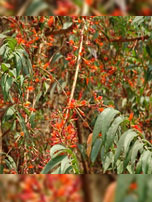SHAHEED KARTAR SINGH SARABHA AYURVEDIC MEDICAL COLLEGE & HOSPITAL
Affiliated to Guru Ravidas Ayurved University, Hoshiarpur Punjab
Affiliated to Guru Ravidas Ayurved University, Hoshiarpur Punjab

Botanical Name : Woodfordia fruticosa Kurz.
Family : Lythraceae
Introduction :
It is one of the most important fermenting agents in Ayurveda. It used for Atisãra & anti-diarrhoeal, Visarpa ,Visa.Loosestrifes make up the family Lythraceae. The crape myrtle is classified as Lagerstroemia indica, the henna as Lawsonia inermis, the water willow as Decodon verticillatus. The typical loosestrife genus is Lythrum. The purple loosestrife is classified as Lythrum salicarial, the hyssop loosestrife as Lythrum hyssopifolia. Loosestrifes of the genus Lysimachia belong to the family Primulaceae.
Names in different Indian languages :
English : Fire-flame Bush,Shiranjitea
Hindi : Davi,tavi,dhay
Kannada : Bela,tamrapuspi
Malayalam : Tatiri,tairippu
Sanskrit : Dhaataki,mandaniyahetu
Tamil : Velakkai,dhattari,jargi
Telugu : Dhataki,jargi,serinji
Synonyms :
Dhaatri, Kunjaraa, Taamrapushpi, Bahupushpi,Vahnijwaalaa
Woodfordia floribunda Salisb.
Lythrum fruiticosum Linn.
Classification according to Charaka, Susrutha & Vagbhata :
Charaka : Purisasangrahaniya, Mutravirajaniya, Sandhãniya
Susrutha : Priyangvadi, Ambastãdi
Vagbhata : Priyangvadi, Ambastãdi
Morphology :
It is a bushy shrub, with long, spreading branches, pubescent, young branchlets attaining a height about 4-6 m.
Leaves- simple, Opposite, grey- pubescent beneath, ovate or linear- lanceolate, acute sub coriaceous with granular dots on the undersurface.
Flowers- numerous, scarlet, showy, tubular or slender pedicels dilated above, borne in axillary clusters-paniculate.
Fruits- capsules, ellipsoid, membranous, included in the calyx. Seeds cuneate-obovate, smooth.
(Flowers in Feb.-April and fruits in April-June).
Distribution & Habitat :
Found throughout India
Chemical constituents :
woodferdins A,B, & C, lawsone, betulin , ellagic acid, polystachoside, myricetin-3-galactoside, octacosanol, chrysophanol-6-O-beta-D-glucopyranoside , beta-sitosterol. Hecogenin, mesoinositol , Oenothein A and B
Properties :
Rasa- Kasãya
Guna- Laghu, Rüksa
Virya-sita
Vipãka Katu
Karma :
Kapha-pitta hara, Madakãri,
Purifies blood, heals ulcers, astringent, haemetemesis, ,constipating, sedative
Indication :
Trsnã,Atisãra,Raktapitta, Krmi, Visarpa, Pradara,erysipelas, diarrhoea, haemorrhages, ulcerations, dysentery, diarrhoea, menorrhagia, leucorrhoea.
Part used : Flowers
Dosage :
Powder 2-4 g
(in preparation like arista as described by text books)
External uses :
Being refrigerant, haemostatic, wound healer. powdered Dower is sprinkled externally over bleeds and wounds. powdered flower is rubbed over gums to prevent teething problems and the juice is used for massage in headache induced by pitta
Internal uses :
Digestive system : It has astringent properties useful in chronic diarrhoea and dysentery. Flower is useful in haemorrhoids
Circulatory system : It has binding and alleviating properly. hence useful in bleeding disorders.
Powder of the flowers is used in heart diseases.
Urinary system : Vitiation of pitta leads to discoloration of urine like dark yellow, red and bluer
The flowers cure such disorders and also used in prameha caused by pitta
Reproductive system : Useful in per vaginal discharges. In menorrhagia or Leucorrhoea, it is given either with rice water or honey or in the form of jam. –
Skin : Kushthaghna, used in erysipelas and other skin disordered
Temperature : Febrifuge. mainly fever caused by pitta dosha. In Konkan region. patient suffering from pittajwar (fever caused by pitta dosha) is asked to hold sesame oil in his mouth and juice of these leaves is applied on the head. This procedure changes the colour of oil to yellow and then the oil should be spitted out Again fresh oil is held in the mouth This procedure is done twice or thrice till oil retains its original colour which indicates the purification of pita dosha.
Important Yogas or Formations :
Dhatakyedi chuma, Dhataki taila. flowers are mainly used in preparing medicines. These flowers are used in making nearly 95% asavas and arishtas for fermentation and as a dyeing agent Dhatakyãdi taila, Dhatakyadi churna, Pusyãnuga cürna, Brhat Gahgadhara curna, Araviñdãsava.
Therapeutic Uses :
(1) Svetapradara- Dhãtaki powder shall be given with honey (V.M).
(2) Prajasthapana- Nilotpala and Dhtaki are, mixed and taken with honey in the morning during the Rtukala (period of ou vlation)-( G .N).
(3) Pittäbhisyañda- The powder or juice of Dhãtaki and Candana are mixed with breast milk and applied as Añjana(S.S.Ut. 10).
